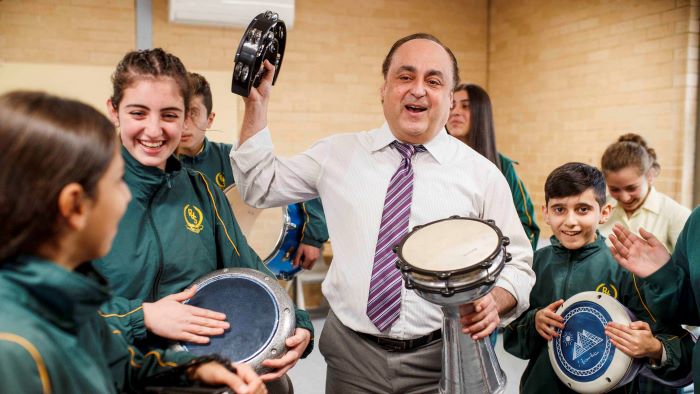Reflection and planning exercise for building the teacher-student relationship
This template is designed for leaders and learning and support teams wanting to support teachers to improve their relationship with a student. This template will provide opportunities for leaders and teachers to work together to:
Reflect on the teacher-student relationship.
Identify opportunities for improvement.
Set goals for improving the teacher-student relationship.
Identify relevant strategies or resources for achieving those goals.
Implement and evaluate whether the chosen strategies resulted in the desired change.

Teachers who have lower levels of confidence in their own abilities to teach and connect with students with disability may benefit from receiving support from mentors when reflecting on the teacher-student relationship. When working through the exercise with teachers, mentors, take time to:
Reflect on the teacher’s understanding of the student, student voice, and the teacher-student relationship. It is important that this is completed together, so that teachers receive support from you, and a shared understanding is developed.
Document examples that support or conflict with the teacher’s reflections. This helps to identify whether there is clear and consistent evidence to support the teacher’s understanding of the student and teacher-student relationship, or if there are gaps or inconsistencies that need further exploration. Concrete examples can include relevant observations, documentation, or feedback from leaders, learning and support teams, teachers, or the student. Clear, concrete and specific examples will best support a deep understanding of the student and the teacher-student relationship.
Set goals with the teacher based on reflections and documentation to clearly identify the actions and support required by you and the teacher to improve the student-teacher relationship. If setting goals with the student may also be appropriate, set goals collaboratively with the teacher, student and parent/carer, taking into account your reflections and documentation for what you want to achieve. SMART goals that are realistic, and build on the teacher’s and student’s existing strengths and skills, will be most helpful. Identify the strategies and resources that will support the goals set in collaboration with the teacher, student and parent or carer. Use strategies that are based on current and successful strategies evaluated in school settings such as our teacher-student relationship guide, and other strategies found on our hub.
Resources may include:
Supports for the teacher, such as professional development, mentoring, administration/classroom supports, or wellbeing supports.
Supports for the student, such as communication strategies for expressing their needs and emotions.
Observe the student and teacher interactions at different times and on different days to monitor how well the planned strategies are achieving the goals set. Have the teacher keep a record of observations relevant to the strategies and relationship. This could include new information gained or learned about the student or themself, successes or difficulties with strategies, and any changes in teacher-student interactions, outcomes or other relevant indicators relevant to goals that were set. In some cases, it may also be helpful to have a leader or someone from the learning and support team make observations, to identify challenges or successes that the teacher may not have picked up on.
Assess whether the strategies worked using observation or relevant data. If not, why? (for example, was it an implementation issue, such as lack of resources, knowledge, or supports? Was the strategy not a good fit? Was the challenge to be addressed not correctly identified?). What strategies are effective and will be retained?
You can watch an example of practice in which the learning and support team provided guidance and support to a teacher experiencing challenges in the teacher-student relationship.
Final reflection:
Difficulties in interpersonal relationships are more likely to occur when we are experiencing stress, or disruptions to our wellbeing. When there have been challenges in the teacher-student relationship, it may at times feel difficult to sustain a positive mindset, and high expectations. Recognising the ways in which stress, wellbeing, a positive mindset, and high expectations can interact with the teacher-student relationship can help open up conversations about the types of strategies, resources or intervention that may support you as a teacher and individual.
The following reflections are optional – consider which you are comfortable sharing with the learning and support team or leader, and which questions you prefer to reflect on privately.
Reflect on your current wellbeing and experience of stress, and the activities you are currently engaging in to manage stress and increase wellbeing. Are there practical and feasible supports, resources or other changes that could be implemented to better support your wellbeing and stress management?
Reflecting on your experience of the teacher-student relationship, what has so far helped you build and maintain high expectations, recognition of strengths, and a positive attitude towards the student? Are there other strategies or supports (including approaches you may have used with other students) that could further strengthen this?
School Excellence Framework alignment
Wellbeing
Effective classroom practice
Australian Professional Standards for Teachers alignment
Standard 1: Know students and how they learn
Audience
School leaders, secondary teachers
Purpose
School leaders can use this planning tool to support teachers to develop their professional relationship with their students
Timeframes and when to use
This resource can be used at any time to provide further information and practice guidance
Evidence base
This resource was developed with the AllPlay Learn team who conducted a series of systematic reviews of the empirical literature, with over 177,000 articles screened. The resources remain up-to-date, with content reflecting best practice reviewed by a world-class multidisciplinary research team, led by Monash University.
Reviewed
June 2022. Share your feedback here